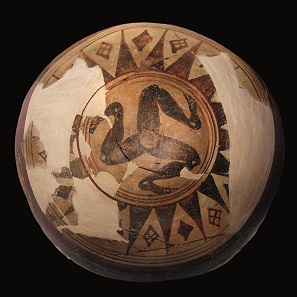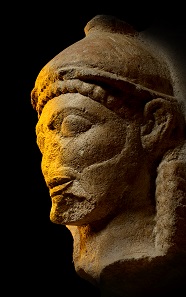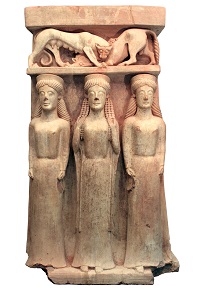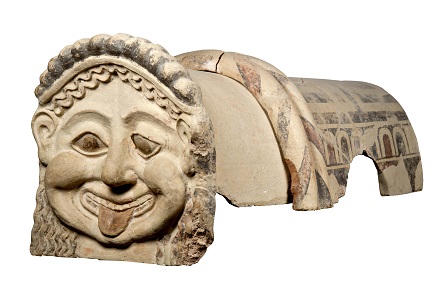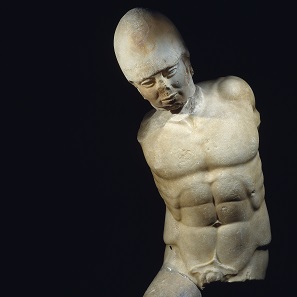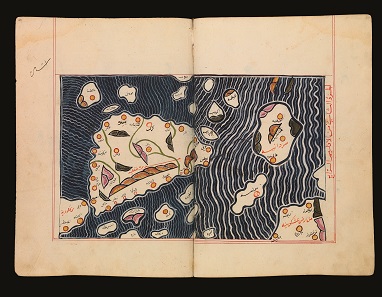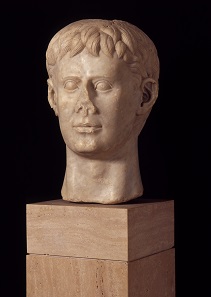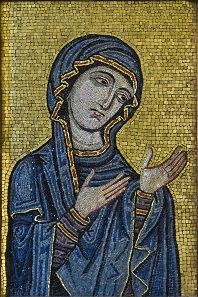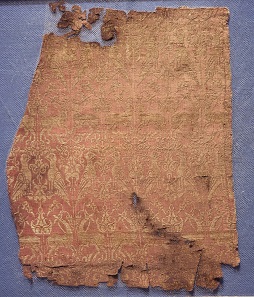April 21, 2016 – On 21 April 2016 the British Museum opens the first exhibition in the UK to explore over 4000 years of history on the island of Sicily. Sponsored by Julius Baer and realised in collaboration with Regione Siciliana, Assessorato dei Beni Culturali e dell’Identità Siciliana, ‘Sicily: culture and conquest’ will provide new insight into the vibrant past of the Italian island familiar to so many visitors today. The exhibition will shed light on the remarkable artistic and architectural achievements of the island through objects in the British Museum’s own collection alongside outstanding loans from Sicily and around the world, including many objects coming to the UK for the very first time.
Ceramic dinos with triskelion, fired clay, Palma di Montechiaro, Sicily, c.650-600 BC. Museo Archeologico Regionale di Agrigento. © Regione Siciliana.
Sicily is the largest island in the Mediterranean and across time it has been shaped by the aspirations of many different peoples and cultures. Its perpetual allure lay in its fertile soil, fed by the volcanic dynamics of Mount Etna. Across time, people from as far and wide as the eastern Mediterranean and northern Europe settled on Sicily, forging a varied and sophisticated culture. The exhibition will focus on two major eras: first, the arrival of the Greeks from the latter half of the 7th century BC and their encounters with earlier settlers and with the Phoenicians, and second the extraordinary period of enlightenment under Norman rule, about AD 1100 to 1250. The exhibition will explore how an astonishingly rich material culture flourished in both of these periods.
Limestone head from a temple. Selinous, Sicily, c. 540-510 BC. Museo Archeologico Regionale A Salinas, Palermo. © Regione Siciliana.
Over 200 objects will be brought together to reveal the richness of the architectural, archaeological and artistic legacies of Sicily. When the Greeks made their first official colony at Naxos in around 735 BC, they brought new ideas and forged cultural and trading links with the earlier indigenous settlers. Sicily’s undemocratically elected rulers, known as ‘Tyrants’, and civic governing bodies displayed their wealth and power through the building of temples, sometimes of colossal dimensions, competing against the largest temples in Greece and the ancient Greek world.
Terracotta altar with three women and a panther mauling a bull. Gela, Sicily, c.500 BC. Museo Archeologico Regionale di Gela. © Regione Siciliana.
A rare and spectacularly well preserved, brightly painted terracotta altar, dating to about 500 BC, is one of the highlights of the loans coming from Sicily. It shows a scene of an animal combat on the upper tier, while below stand three striking fertility goddesses.
Terracotta roof ornament with head of a gorgon, Gela, Sicily, c.500 BC. Museo Archeologico Regionale Di Agrigento. © Regione Siciliana.
The British Museum is also fortunate to be receiving on loan a magnificent terracotta architectural sculpture of a Gorgon, the famous Greek monster, that was once perched on the highest point of a building at Gela in south-east Sicily. Terracotta ornaments were frequently used to decorate the upper levels of buildings on Sicily and are amongst the finest that have survived from the ancient world.
Marble statue of warrior, Akragas, Sicily, c.470 BC. Museo Archeologico Regionale di Agrigento. © Regione Siciliana.
Another important Sicilian loan is a rare and iconic marble sculpture of a warrior from ancient Akragas, modern Agrigento. Marble statues were likely to have been commissioned, carved and imported into Sicily from overseas or made by local sculptors, trained in the Greek tradition. Such rare statues decorated major temples or were part of sculptural groups, most of which are long gone.
After a long series of wars involving Greek Sicilians, Carthaginians, and Romans, the island was eventually conquered by Rome. The exhibition will include a direct remnant of the final battle of that conquest which took place on 10 March 241 BC:
Bronze rostrum from Roman warship, from the seabed near Levanzo, Sicily. c.240 BC. Soprintendenza del Mare. © Regione Siciliana.
Detail close up of bronze rostrum from Roman warship, from the seabed near Levanzo, Sicily. c.240 BC. Soprintendenza del Mare. © Regione Siciliana.
… a bronze battering ram that was fitted on the front of the Roman warships to sink enemy ships, and which was only recently excavated from the waters around the island. For Rome, Sicily’s primary role was to supply its population and its armies with grain; otherwise it cared little for the province. Following Rome’s ‘fall’, Christian Byzantines and Muslim Arabs competed for domination over Sicily, each ruling the island for several centuries. At the end of the 11th century, however, Norman mercenaries who had been settling and ruling in the south of Italy, in turn conquered the island, now inhabited by Byzantine Greek, Muslim, Jewish and Norman people. Under Kings Roger II, William I and William II, Sicily once again became one of the Mediterranean superpowers, easily rivaling the Byzantine Empire in the East, the Fatimid Caliphate of Egypt and the Papal States around Rome.
A tombstone in four languages, Marble, Palermo, Sicily, AD 1149. Soprintendenza di Palermo. © Regione Siciliana.
Through the coexistence of Norman, Islamic and Byzantine cultures on Sicily, Roger II created a climate of multicultural collaboration. Unique forms of art and architecture emerged from the mixture of influences. In 2015 nine buildings in the Arab- Norman style that emerged in Palermo and the surrounding area were elected as UNESCO world heritage.
Lid of a casket with peacock decoration, Enamel, gold, copper, Probably Sicily, c.1250-1300. © The Trustees of the British Museum.
Coming on loan from several of these buildings are a twelfth-century Byzantine-style mosaic, and marble and wooden Islamic-influenced architectural decorations that will give visitors a sense of this extraordinary architectural style that emerged under Roger II. At the same time, the palace workshops produced beautiful objects, from ceremonial glassware and ivory, gold pendants and intricate enamel mosaics and cameos. Each object demonstrates the skills of the craftsmen and the variety of cultural influences that inspired their artistic production and experimentation.
A double page map of Sicily from Al-Idrisi’s 12th-century Tabula Rogeriana. MS. Pococke 375, folios 187v-188r., Unknown, copy from c.1300-1500 AD. © The Bodleian Libraries, University of Oxford.
Roger also welcomed scholars of all races and faiths to his court and took a direct interest in scientific innovation. The exhibition will display one of the oldest surviving copies of a new world map that Roger commissioned from al-Idrisi, an Arab cartographer, instructing him to base it on new research.
Marble bust of Frederick II, Italy, 1220-50 AD. Deutsches Archäologisches Institut, Rome.
The interest in innovation and scientific experiment was continued by Roger II’s grandson, Frederick II, who as Holy Roman Emperor ruled a large part of Europe, but based his court in Palermo. His desire to found a new Roman Empire was unfulfilled when he died heirless, and for the rest of its history, Sicily returned to being part of larger empires and states, rather than being its own master.
Byzantine-style mosaic showing the Virgin as Advocate for the Human Race. Kept at Museo Diocesano di Palermo, originally from Palermo Cathedral, c.1130-1180 AD. Museo Diocesano di Palermo.
The British Museum has worked closely with the Sicilian Ministry of Culture since 2010 on several loans, both at the British Museum and in Sicily. This exhibition presents the next collaboration between curators of the British Museum and Sicily. Objects of outstanding cultural significance have been carefully selected through consultation with Sicilian specialists from different museums across the island. These objects will be displayed alongside loans from Italy, the US and the UK, as well as items from the British Museum collection. The exhibition will also be accompanied by an events program with contributions by Sicilian lecturers and artists.
Gilded bronze falcon, Bronze, traces of gold, Sicily or southern Italy, 1200-1220 AD. © The Metropolitan Museum of Art.
Joanna Mackle, deputy director of the British Museum said, “It gives me great pleasure to announce the British Museum’s exhibition on the rich cultural history of Sicily. We are hugely grateful to Julius Baer for their long term partnership with the British Museum and their generous support of this exhibition. We are also delighted to be working in collaboration with Sicilian colleagues to bring the fascinating story of this island to life.”
Fragments of the funerary robe of Henry VI, red-and-gold lampas silk, tomb of Henry VI, Palermo, Sicily, AD 1197. © The Trustees of the British Museum.
David Durlacher, Julius Baer International Limited, said: “Julius Baer, the international reference in wealth management, is proud to continue its long-lasting partnership with the British Museum, and to support the 2016 exhibition Sicily: culture and conquest. The exhibition will provide a fantastic insight into how Sicily has been shaped by many different peoples over centuries. By developing a long-term partnership with the British Museum, Julius Baer shows its commitment and passion for arts and culture.”
Gold libation bowl decorated with six bulls, Sant’ Angelo Muxaro, c.600 BC. © The Trustees of the British Museum.
Carlo Vermiglio, Minister of Cultural Heritage of the Autonomous Region of Sicily, said: “We are honoured to be in the British Museum today for the presentation of the exhibition Sicily: Culture and Conquest, dedicated to Sicily. This exhibition is part of a cultural cooperation between this prestigious museum and the Ministry of Cultural Heritage of Sicily. We hope that we can continue on this path and therefore we are still open to and ready for new initiatives that will make our region known throughout the world for its outstanding cultural patrimony.”
The exhibition will go through 14 August 2016 in Room 35 in the British Museum. A full public programme will accompany the exhibition. The exhibition catalogue will be available from April 2016 by British Museum Press: Sicily: culture and conquest, edited by Dirk Booms and Peter Higgs. A rich and vivid account of the island of Sicliy and its diverse cultural history, £30.00 (paperback).
For more information go to the British Museum website or follow updates on the exhibition via Twitter.
And here you will find the marvellous trailer of the exhibition on YouTube.
If you want to know where all these treasures come from, accompany us on our numismatic journey to Sicily in 2014.




